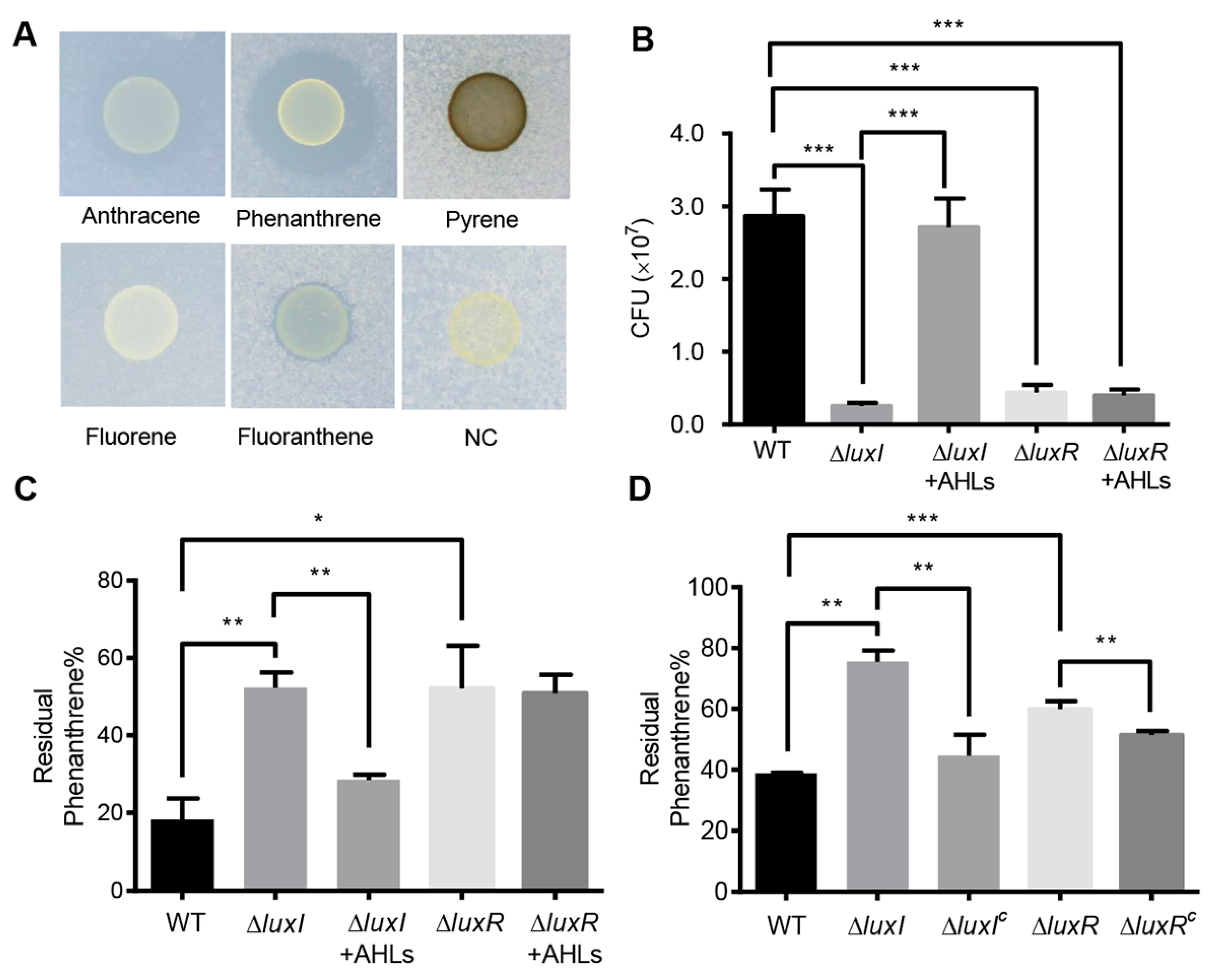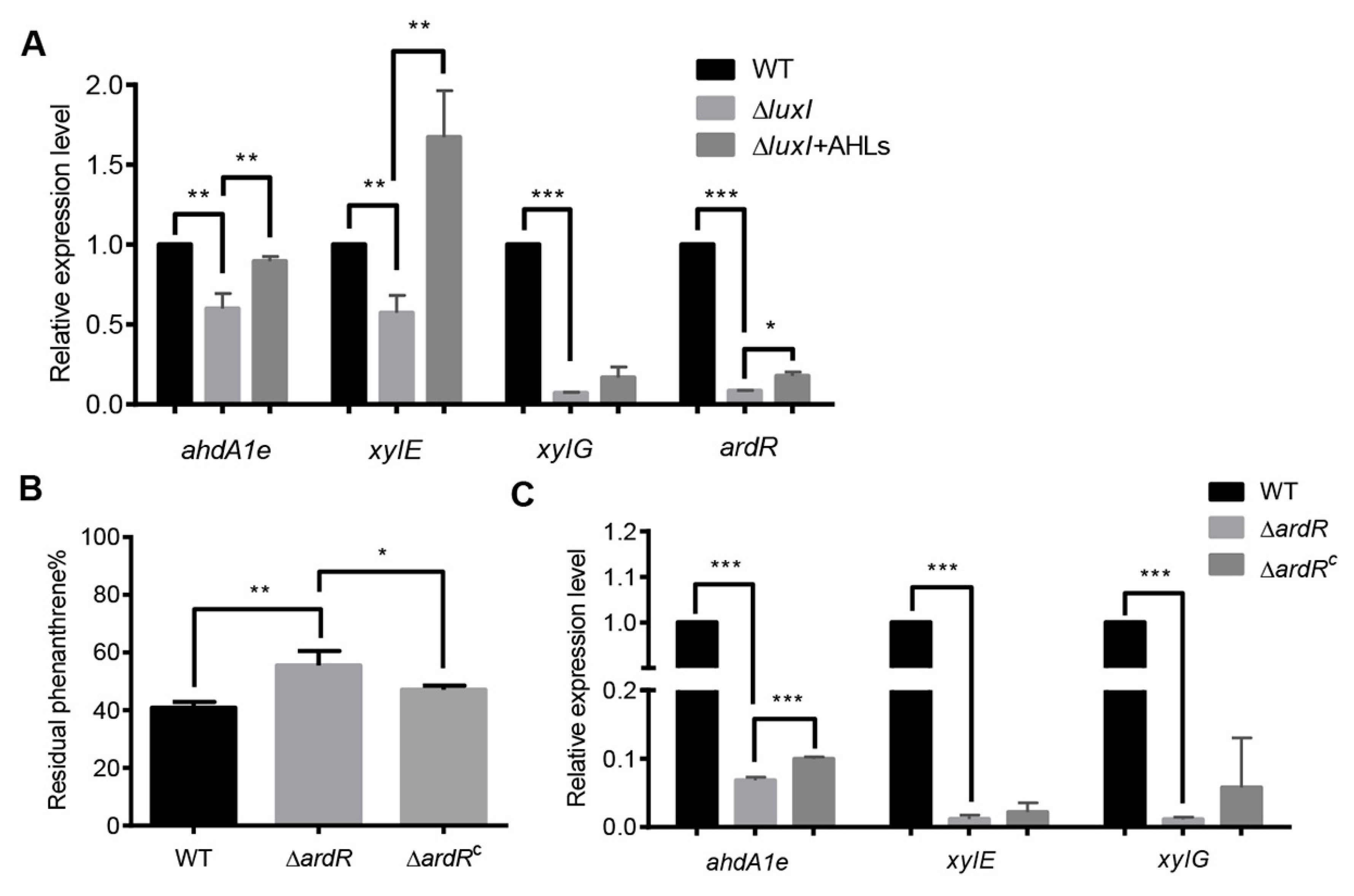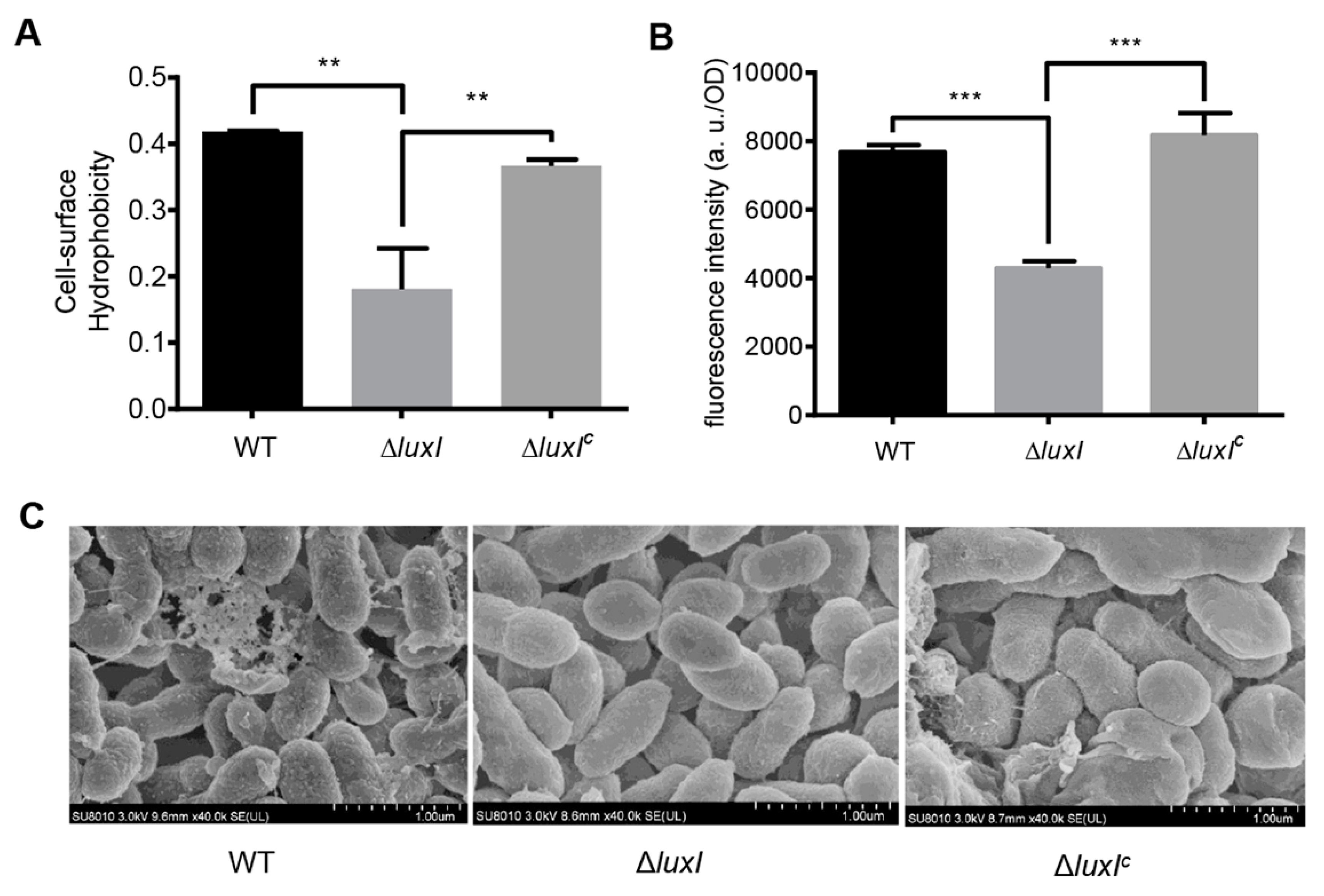The LuxI/LuxR-Type Quorum Sensing System Regulates Degradation of Polycyclic Aromatic Hydrocarbons via Two Mechanisms
Abstract
:1. Introduction
2. Results
2.1. Identification of an AHL-Type QS System in C. naphthovorans PQ-2
2.2. The AHL-Type QS System Is Crucial for the Degradation of PAHs
2.3. PQ-2 Degrades Phenanthrene through the Salicylic Acid Pathway
2.4. The Large Plasmid Is Responsible for the Degradation of Phenanthrene
2.5. The AHL-Type QS System Regulates the Expression of PAH-Degrading Genes
2.6. The AHL-Type QS System Affects Bacterial Cell Surface Hydrophobicity
3. Discussion
4. Materials and Methods
4.1. Bacterial Strains, Plasmids, Primers and Culture Conditions
4.2. Expression of AHL Synthase of Strain PQ-2 in E. coli
4.3. Extraction and Analysis of AHLs
4.4. Cross-Feeding Bioassay
4.5. Markerless Gene Deletion Mutagenesis and Complementation
4.6. RNA Isolation and Quantitative Real-Time PCR (qRT-PCR)
4.7. Analysis of Phenanthrene and Its Metabolites
4.8. Microbial Adhesion to Hydrocarbons (MATH) Test
4.9. Determination of Hydrophobic Proteins Using Fluorescent Dye
4.10. Scanning Electron Microscopy (SEM)
5. Conclusions
Supplementary Materials
Author Contributions
Funding
Conflicts of Interest
Abbreviations
| QS | Quorum Sensing |
| AHL | Acylated Homoserine Lactone |
| PAHs | Polycyclic Aromatic Hydrocarbons |
| CSH | Cell Surface Hydrophobicity |
| DAP | 2,6-Daminopimelic Acid |
| MATH | Microbial Adhesion to Hydrocarbons |
| CFUs | Colony-forming Units |
| OD | Optical Denstity |
| TCA | Tricarboxylic Acid |
| SEM | Scanning Electron Microscopy |
| TLC | Thin Layer Chromatography |
| ArdR | Aromatic Degradation Regulator |
References
- Bassler, B.L.; Losick, R. Bacterially speaking. Cell 2006, 125, 237–246. [Google Scholar] [CrossRef] [Green Version]
- Rutherford, S.T.; Bassler, B.L. Bacterial quorum sensing: Its role in virulence and possibilities for its control. Cold Spring Harb. Perspect. Med. 2012, 2, a012427. [Google Scholar] [CrossRef] [PubMed]
- Whiteley, M.; Diggle, S.P.; Greenberg, E.P. Progress in and promise of bacterial quorum sensing research. Nature 2017, 551, 313–320. [Google Scholar] [CrossRef] [PubMed]
- Papenfort, K.; Bassler, B.L. Quorum sensing signal-response systems in Gram-negative bacteria. Nat. Rev. Microbiol. 2016, 14, 576–588. [Google Scholar] [CrossRef] [PubMed]
- Fuqua, W.C.; Winans, S.C.; Greenberg, E.P. Quorum sensing in bacteria: The LuxR-LuxI family of cell density-responsive transcriptional regulators. J. Bacteriol. 1994, 176, 269–275. [Google Scholar] [CrossRef] [PubMed] [Green Version]
- Samanta, S.K.; Singh, O.V.; Jain, R.K. Polycyclic aromatic hydrocarbons: Environmental pollution and bioremediation. Trends Biotechnol. 2002, 20, 243–248. [Google Scholar] [CrossRef]
- Kim, K.H.; Jahan, S.A.; Kabir, E.; Brown, R.J. A review of airborne polycyclic aromatic hydrocarbons (PAHs) and their human health effects. Environ. Int. 2013, 60, 71–80. [Google Scholar] [CrossRef]
- Peng, R.H.; Xiong, A.S.; Xue, Y.; Fu, X.Y.; Gao, F.; Zhao, W.; Tian, Y.S.; Yao, Q.H. Microbial biodegradation of polyaromatic hydrocarbons. FEMS Microbiol. Rev. 2008, 32, 927–955. [Google Scholar] [CrossRef] [Green Version]
- Haritash, A.K.; Kaushik, C.P. Biodegradation aspects of polycyclic aromatic hydrocarbons (PAHs): A review. J. Hazard. Mater. 2009, 169, 1–15. [Google Scholar] [CrossRef]
- Stolz, A. Molecular characteristics of xenobiotic-degrading sphingomonads. Appl. Microbiol. Biotechnol. 2009, 81, 793–811. [Google Scholar] [CrossRef]
- Waigi, M.G.; Kang, F.; Goikavi, C.; Ling, W.; Gao, Y. Phenanthrene biodegradation by sphingomonads and its application in the contaminated soils and sediments: A review. Int. Biodeter. Biodegr. 2015, 104, 333–349. [Google Scholar] [CrossRef]
- Ghosal, D.; Ghosh, S.; Dutta, T.K.; Ahn, Y. Current state of knowledge in microbial degradation of polycyclic aromatic hydrocarbons (PAHs): A review. Front. Microbiol. 2016, 7, 1369. [Google Scholar] [CrossRef] [PubMed] [Green Version]
- Yong, Y.C.; Zhong, J.J. Regulation of aromatics biodegradation by rhl quorum sensing system through induction of catechol meta-cleavage pathway. Bioresour. Technol. 2013, 136, 761–765. [Google Scholar] [CrossRef] [PubMed]
- Mangwani, N.; Kumari, S.; Das, S. Involvement of quorum sensing genes in biofilm development and degradation of polycyclic aromatic hydrocarbons by a marine bacterium Pseudomonas Aeruginosa N6P6. Appl. Microbiol. Biotechnol. 2015, 99, 10283–10297. [Google Scholar] [CrossRef] [PubMed]
- Chen, A.; Huang, Y. Acyl-homoserine lactone based quorum sensing affects phenanthrene removal by Novosphingobium pentaromativorans US6-1 through altering cell surface properties. Int. Biodeter. Biodegr. 2020, 147, 104841. [Google Scholar] [CrossRef]
- Huang, Y.; Zeng, Y.; Yu, Z.; Zhang, J.; Feng, H.; Lin, X. In silico and experimental methods revealed highly diverse bacteria with quorum sensing and aromatics biodegradation systems−a potential broad application on bioremediation. Bioresour. Technol. 2013, 148, 311–316. [Google Scholar] [CrossRef] [PubMed]
- Huang, Y.; Zeng, Y.; Feng, H.; Wu, Y.; Xu, X. Croceicoccus naphthovorans sp. nov., a polycyclic aromatic hydrocarbons-degrading and acylhomoserine-lactone-producing bacterium isolated from marine biofilm, and emended description of the genus Croceicoccus. Int. J. Syst. Evol. Microbiol. 2015, 65, 1531–1536. [Google Scholar] [CrossRef] [PubMed]
- Gao, J.; Ma, A.; Zhuang, X.; Zhuang, G. An N-acyl homoserine lactone synthase in the ammonia-oxidizing bacterium Nitrosospira multiformis. Appl. Environ. Microbiol. 2014, 80, 951–958. [Google Scholar] [CrossRef] [Green Version]
- McLean, R.J.; Whiteley, M.; Stickler, D.J.; Fuqua, W.C. Evidence of autoinducer activity in naturally occurring biofilms. FEMS Microbiol. Lett. 1997, 154, 259–263. [Google Scholar] [CrossRef]
- Kaczmarczyk, A.; Vorholt, J.A.; Francez-Charlot, A. Markerless gene deletion system for sphingomonads. Appl. Environ. Microbiol. 2012, 78, 3774–3777. [Google Scholar] [CrossRef] [Green Version]
- Peng, X.; Shindo, K.; Kanoh, K.; Inomata, Y.; Choi, S.K.; Misawa, N. Characterization of Sphingomonas aldehyde dehydrogenase catalyzing the conversion of various aromatic aldehydes to their carboxylic acids. Appl. Microbial. Biotechnol. 2005, 69, 141–150. [Google Scholar] [CrossRef] [PubMed]
- Zhao, Z.; Selvam, A.; Wong, J.W. Effects of rhamnolipids on cell surface hydrophobicity of PAH degrading bacteria and the biodegradation of phenanthrene. Bioresour. Technol. 2011, 102, 3999–4007. [Google Scholar] [CrossRef] [PubMed]
- Kumari, S.; Mangwani, N.; Das, S. Synergistic effect of quorum sensing genes in biofilm development and PAHs degradation by a marine bacterium. Bioengineered 2016, 7, 205–211. [Google Scholar] [CrossRef] [PubMed] [Green Version]
- Kertesz, M.A.; Kawasaki, A.; Stolz, A. Aerobic hydrocarbon-degrading alphaproteobacteria: Sphingomonadales. In Taxonomy, Genomics and Ecophysiology of Hydrocarbon-Degrading Microbes, 1st ed.; McGenity, T.J., Ed.; Springer: Cham, Switzerland, 2018; pp. 105–124. [Google Scholar]
- Mallick, S.; Chakraborty, J.; Dutta, T.K. Role of oxygenases in guiding diverse metabolic pathways in the bacterial degradation of low-molecular-weight polycyclic aromatic hydrocarbons: A review. Crit. Rev. Microbiol. 2011, 37, 64–90. [Google Scholar] [CrossRef]
- Obayori, O.S.; Salam, L.B. Degradation of polycyclic aromatic hydrocarbons: Role of plasmids. Sci. Res. Essays 2010, 5, 4093–4106. [Google Scholar]
- Pinyakong, O.; Habe, H.; Yoshida, T.; Nojiri, H.; Omori, T. Identification of three novel salicylate 1-hydroxylases involved in the phenanthrene degradation of Sphingobium sp. strain P2. Biochem. Biophys. Res. Commun. 2003, 301, 350–357. [Google Scholar] [CrossRef]
- Fernandez, S.; Shingler, V.; De Lorenzo, V. Cross-regulation by XylR and DmpR activators of Pseudomonas putida suggests that transcriptional control of biodegradative operons evolves independently of catabolic genes. J. Bacteriol. 1994, 176, 5052–5058. [Google Scholar] [CrossRef] [Green Version]
- Segura, A.; Hernández-Sánchez, V.; Marqués, S.; Molina, L. Insights in the regulation of the degradation of PAHs in Novosphingobium sp. HR1a and utilization of this regulatory system as a tool for the detection of PAHs. Sci. Total. Environ. 2017, 590, 381–393. [Google Scholar] [CrossRef]
- Rosenberg, M.E.L. Bacterial adherence to polystyrene: A replica method of screening for bacterial hydrophobicity. Appl. Environ. Microbiol. 1981, 42, 375–377. [Google Scholar] [CrossRef] [Green Version]
- Gumargalieva, K.Z.; Kalinina, I.G.; Mironova, S.N.; Zaikov, G.E. Biodegradation of polymers and adhesion properties of microorganism cells. Polym. Degrad. Stabil. 1995, 47, 363–368. [Google Scholar] [CrossRef]
- Das, K.; Mukherjee, A.K. Differential utilization of pyrene as the sole source of carbon by Bacillus subtilis and Pseudomonas aeruginosa strains: Role of biosurfactants in enhancing bioavailability. J. Appl. Microbiol. 2007, 102, 195–203. [Google Scholar] [CrossRef] [PubMed]
- Sohn, J.H.; Kwon, K.K.; Kang, J.H.; Jung, H.B.; Kim, S.J. Novosphingobium pentaromativorans sp. nov., a high-molecular-mass polycyclic aromatic hydrocarbon-degrading bacterium isolated from estuarine sediment. Int. J. Syst. Evol. Microbiol. 2004, 54, 1483–1487. [Google Scholar] [CrossRef] [PubMed] [Green Version]
- Edwards, S.J.; Kjellerup, B.V. Applications of biofilms in bioremediation and biotransformation of persistent organic pollutants, pharmaceuticals/personal care products, and heavy metals. Appl. Microbiol. Biotechnol. 2013, 97, 9909–9921. [Google Scholar] [CrossRef] [PubMed]
- Yin, J.; Zhang, T.; Cai, J.; Lou, J.; Cheng, D.; Zhou, W.; Xu, C.; Liu, Y.; Gao, H.; Yu, Z. PBP1a glycosyltransferase and transpeptidase activities are both required for maintaining cell morphology and envelope integrity in Shewanella oneidensis. FEMS Microbiol. Lett. 2020, 367, fnaa026. [Google Scholar] [CrossRef]
- Yu, Z.; Yu, D.; Mao, Y.; Zhang, M.; Ding, M.; Zhang, J.; Wu, S.; Qiu, J.; Yin, J. Identification and characterization of a LuxI/R-type quorum sensing system in Pseudoalteromonas. Res. Microbiol. 2019, 170, 243–255. [Google Scholar] [CrossRef]
- Biswa, P.; Doble, M. Production of acylated homoserine lactone by Gram-positive bacteria isolated from marine water. FEMS Microbiol. Lett. 2013, 343, 34–41. [Google Scholar] [CrossRef] [Green Version]
- Saravanabhavan, G.; Helferty, A.; Hodson, P.V.; Brown, R.S. A multi-dimensional high performance liquid chromatographic method for fingerprinting polycyclic aromatic hydrocarbons and their alkyl-homologs in the heavy gas oil fraction of Alaskan North Slope crude. J. Chromatogr. A 2007, 1156, 124–133. [Google Scholar] [CrossRef]
- Keum, Y.S.; Seo, J.S.; Hu, Y.; Li, Q.X. Degradation pathways of phenanthrene by Sinorhizobium sp. C4. Appl. Microbiol. Biotechnol. 2006, 71, 935–941. [Google Scholar] [CrossRef]
- Wu, M.L.; Nie, M.Q.; Wang, X.C.; Su, J.M.; Cao, W. Analysis of phenanthrene biodegradation by using FTIR, UV and GC-MS. Spectrochim. Acta. A Mol. Biomol. Spectrosc. 2010, 75, 1047–1050. [Google Scholar] [CrossRef]
- Rosenberg, M.; Rosenberg, E. Role of adherence in growth of Acinetobacter calcoaceticus RAG-1 on hexadecane. J. Bacteriol. 1981, 148, 51–57. [Google Scholar] [CrossRef] [Green Version]
- Miklavžin, A.; Cegnar, M.; Kerc, J.; Kristl, J. Effect of surface hydrophobicity of therapeutic protein loaded in polyelectrolyte nanoparticles on transepithelial permeability. Acta Pharm. 2018, 68, 275–293. [Google Scholar] [CrossRef] [PubMed] [Green Version]
- Coppotelli, B.M.; Ibarrolaza, A.; Dias, R.L.; Del Panno, M.T.; Berthe-Corti, L.; Morelli, I.S. Study of the degradation activity and the strategies to promote the bioavailability of phenanthrene by Sphingomonaspaucimobilis strain 20006FA. Microb. Ecol. 2010, 59, 266–276. [Google Scholar] [CrossRef] [PubMed]






| Strain or Plasmid | Description | Source or Reference |
|---|---|---|
| Strains | ||
| C. naphthovorans PQ-2 | Wild type | [16] |
| A. tumefaciens A136 (pCF218/pCF372) | biosensor strain for medium-/long-chain AHLs | [19] |
| E. coli DH5α | Host strain for cloning | Lab stock |
| E. coli BL21(DE3) | Expression host for pET28b(+) | TransGen Biotech |
| E. coli WM3064 | Donor strain for conjugation | [35] |
| ΔluxI | Mutant of strain PQ-2 with deletion of luxI | This study |
| ΔluxR | Mutant of strain PQ-2 with deletion of luxR | This study |
| ΔardR | Mutant of strain PQ-2 with deletion of ardR | This study |
| ΔP1 | Mutant of strain PQ-2 with deletion of the large plasmid | This study |
| ΔluxIC | Complemented strain of ΔluxI | This study |
| ΔluxRC | Complemented strain of ΔluxR | This study |
| ΔardRC | Complemented strain of ΔardR | This study |
| Plasmids | ||
| pBBR1MCS-5 | Gmr, broad-host vector | [36] |
| pET-28b(+) | T7 expression vector | Novagen |
| pET-28b(+)-luxI | pET-28b(+) containing AHL synthase LuxI | This study |
| pAK405 | Kmr, sphingomonad suicide vector | [20] |
© 2020 by the authors. Licensee MDPI, Basel, Switzerland. This article is an open access article distributed under the terms and conditions of the Creative Commons Attribution (CC BY) license (http://creativecommons.org/licenses/by/4.0/).
Share and Cite
Yu, Z.; Hu, Z.; Xu, Q.; Zhang, M.; Yuan, N.; Liu, J.; Meng, Q.; Yin, J. The LuxI/LuxR-Type Quorum Sensing System Regulates Degradation of Polycyclic Aromatic Hydrocarbons via Two Mechanisms. Int. J. Mol. Sci. 2020, 21, 5548. https://doi.org/10.3390/ijms21155548
Yu Z, Hu Z, Xu Q, Zhang M, Yuan N, Liu J, Meng Q, Yin J. The LuxI/LuxR-Type Quorum Sensing System Regulates Degradation of Polycyclic Aromatic Hydrocarbons via Two Mechanisms. International Journal of Molecular Sciences. 2020; 21(15):5548. https://doi.org/10.3390/ijms21155548
Chicago/Turabian StyleYu, Zhiliang, Zeyu Hu, Qimiao Xu, Mengting Zhang, Nate Yuan, Jiongru Liu, Qiu Meng, and Jianhua Yin. 2020. "The LuxI/LuxR-Type Quorum Sensing System Regulates Degradation of Polycyclic Aromatic Hydrocarbons via Two Mechanisms" International Journal of Molecular Sciences 21, no. 15: 5548. https://doi.org/10.3390/ijms21155548





